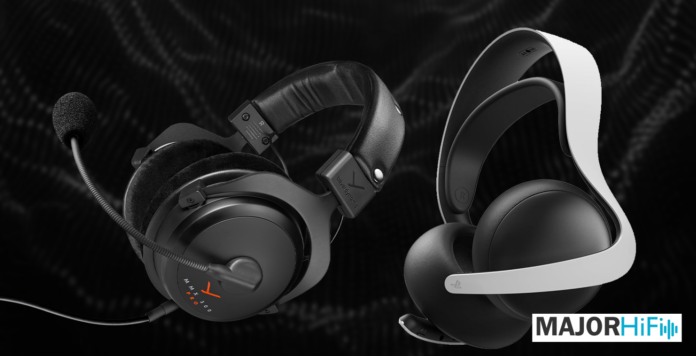Gaming headphones with true detailed sound can be hard to come by. Both Sony and Beyerdynamic are respected enough names in the headphone world, and have their own line of gaming headphones. They both have high expectations in terms of their sound quality, so let’s see how they stack up against each other with the PlayStation Pulse Elite and the MMX 300 Pro.
What You Get
| Pulse Elite | MMX 300 Pro |
|
|
Look & Feel
These headphones have completely different designs. The Pulse Elite is meant to resemble the PS5, while the MMX 300 Pro resembles Beyerdynamic’s Pro line of headphones like the DT 770 and DT 990. This brings different impressions of value, as the MMX 300 Pro looks and feels like a higher-grade build compared to the Pulse Elite. It definitely has a sturdier frame thanks to the aluminum yokes. With the Pulse Elite, you have mainly plastic parts but the design is still practical and comfortable. The Elite is smaller and lighter than the MMX 300 Pro which has a clamping fit that most Beyerdynamic headphones have. I find them both comfortable, with the MMX 300 Pro having the best seal.
Design
It’s the MMX 300 Pro’s dynamic driver versus the Pulse Elite’s planar driver. All the differences between these designs stem from one being exclusively wired, and the other being exclusively wireless. They both technically provide lossless audio, the Elite through the PlayStation Link dongle, and the MMX 300 Pro with its standard headphone jack. You get more features using the Pulse Elite, including spatial audio.
Microphone Quality
The MMX 300 Pro has superior voice clarity compared to the Pulse Elite. This comes down to having a better microphone that captures your voice’s natural qualities more directly. The Pulse Elite relies on its AI-enhanced noise rejection, but the actual transparency of your voice is messier.
Soundstage
There are a lot of differences between these two headphone soundstages that aren’t just 3D audio related. The Pulse Elite and the MMX 300 Pro have good stereo imaging without spatial features, with the MMX 300 Pro being the most accurate and precise of the two. With the Pulse Elite, the natural stereo field is breathable, but spatial positioning is not as articulate as the MMX 300 Pro. Sound effects appear more exact during games on the MMX 300 Pro, even if the Pule Elite does a better job communicating distance, especially in 3D. I preferred to keep the Pulse Elite in 3D during most of my playtime to hear the better soundstage and imaging, but with the MMX 300 Pro, I didn’t wish it to have spatial features. The Pulse Elite kind of needs it for game audio to feel immersive, while the MMX 300 Pro is more naturally layered.
Low End
With gaming headphones, you expect an eventful bass no matter what, and both headphones deliver on that. Through the PS5 you can access an EQ that helps boost the bass of the Pulse Elite, which elevates its response more than the MMX 300 Pro. However, the Pro contains more thunderous qualities compared to what you usually get from the brand. It rivals the Pulse Elite with its realistic, smooth detail. The Elite has great texture and even has a tighter grip on its tone, but the MMX 300 Pro feels more naturally engrossing. Both headphones are similarly engaged in their low frequencies, but the Elite relies more on color than pure character.
Mids
Neither the Pulse Elite nor the MMX 300 Pro has the most transparent midrange, but one certainly comes across more elegantly than the other. It’s the MMX 300 Pro that has a greater range of articulation than the Pulse Elite, with effects and musical instruments taking a clearer shape in the mix. Each sound feels more specific to its intended space, but both sound signatures have a solid impact. The Pulse Elite has an emphasized upper-midrange that tries to make up for some of its more hollow features that the MMX 300 Pro treats with more fullness. I found it refreshing to hear the more neutral timbre of Beyerdynamic’s sound profile in a pair of gaming headphones, as it does a better job providing evenness and cohesion in the mids compared to the Pulse Elite.
Highs
You might be surprised by the role reversal the treble plays in these headphones. This time it’s the Sony headphones that have the brighter timbre. Usually, Beyerdynamic’s headphones are very cutting in their highs, but the MMX 300 Pro is considerably dryer than the Pulse Elite. Sony’s headphones have a consistent sizzle that feels biting. There’s a sharpness to it that accentuates certain effects in games, especially ones with a distinguishable reverb tail. The MMX 300 Pro is similarly sharp in places, but it never lets it loose. Instead, the MMX 300 Pro tries to have it both ways and ends up veiling a lot of high-frequency detail that doesn’t provide as much flavor.
Summary
Comparing these two gaming headphones together has some mixed results. The Pulse Elite and the MMX 300 Pro have similar amounts of pros and cons. Sound-wise, they share similarities in their base and stereo imaging but diverge in the mids and highs. I prefer the MMX 300 Pro’s more natural sound qualities, but the Elite’s spatial audio and extended highs are very immersive to me. If you’re looking for the best mic quality, then the MMX 300 Pro is the clearest winner.
The Sony PlayStation Pulse Elite is available here, and you can find the Beyerdynamic MMX 300 Pro at Audio46.
MAJORHIFI may receive commissions from retail offers.








